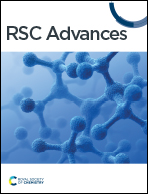Enhanced pseudocapacitive energy storage and thermal stability of Sn2+ ion-intercalated molybdenum titanium carbide (Mo2TiC2) MXene†
Abstract
Electrochemical energy-storage (EES) devices are a major part of energy-storage systems for industrial and domestic applications. Herein, a two-dimensional (2D) transition metal carbide MXene, namely Mo2TiC2, was intercalated with Sn ions to study the structural, morphological, optical, and electrochemical energy-storage effects. The Sn2+-intercalated modified layered structure, prepared via a facile liquid-phase pre-intercalated cetyltrimethylammonium bromide (CTAB) method, showed a higher surface area of 30 m2 g−1, low band gap of 1.3 eV, and large interlayer spacing of 1.47 nm, as compared to the pristine Mo2TiC2. The Sn@Mo2TiC2 electrode showed a high specific capacitance of 670 F g−1, representing a large diffusion control value compared to pure Mo2TiC2 (212 F g−1) at a scan rate of 2 mV s−1. The modified electrode also presented long-term cyclic performance, high-capacity retention and coulombic efficiency measured over 10 000 cycles. The Sn@Mo2TiC2 electrode showed much improved electrocatalytic efficiency, which may open up ways to employ double-transition 2D MXenes in energy-storage devices.



 Please wait while we load your content...
Please wait while we load your content...